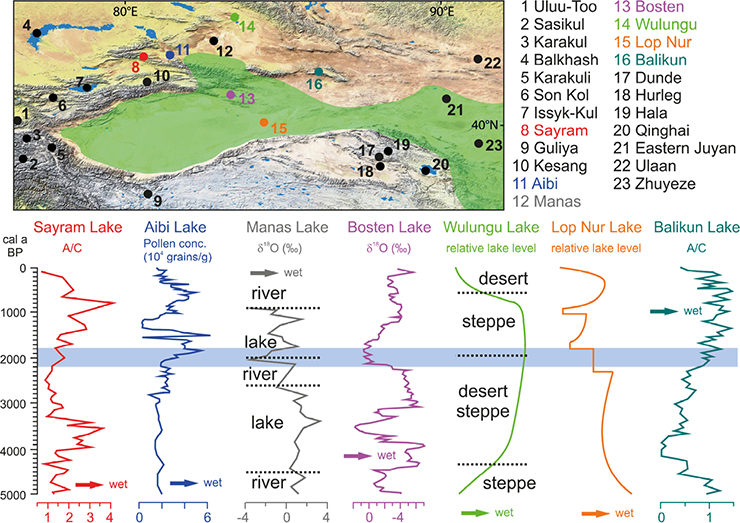- Home
- Publications
- PAGES Magazine
- The Role of Environment In The Socio-Cultural Changes of The Ancient Silk Road Area
The Role of Environment in the Socio-Cultural Changes of the Ancient Silk Road Area
Liang Emlyn Yang, J. Wiesehöfer, H.-R. Bork and M. Hoo
Past Global Changes Magazine
25(3)
165
2017
Liang Emlyn Yang1, J. Wiesehöfer2, H.-R. Bork3 and M. Hoo1,2
Kiel, Germany, 28-29 September 2017
The Silk Road is a modern concept for an ancient network of trade routes that for centuries facilitated and intensified processes of cultural interaction and goods exchange between West China, Central Asia, the Middle East, and the Mediterranean (Elisseeff 2001). The Silk Road flourished when the Han dynasty explored Central Asia around 139 BCE and thrived throughout the Middle Ages and eventually declined under the Islamic and Mongol Empires. There is increasing discussion that climatic and environmental factors may have played a role in fostering economic and socio-cultural changes along the Silk Road and in a broader area (Zhang et al. 2011). Coherent patterns and synchronous events in history suggest possible links between social upheaval, resource utilization, and climate or environment forces (Clarke et al. 2016; Mischke et al. 2017). Such links between climatic, environmental, economic, social, and cultural changes would have manifested themselves differently according to place and time; however, it often remains unclear if and how exactly they affected socio-cultural situations on the ground.
The international workshop “The Rise and Fall: Environmental Factors in the Socio-Cultural Changes of the Ancient Silk Road Area” was held at Kiel University. The Silk Road served as the geographical scope and inspirational concept for the workshop. Nineteen researchers from 12 countries presented topics on the expansion of Ancient China to the west; Central Asia as the key node area of the Silk Road; historical water and agriculture systems; climate and environment disasters in the past; climate links to social evolution; and changes of lake and sea regions from ancient to recent periods. The presentations investigated both perspectives of socio-environmental interactions; it became clear, for instance, that climate change provided better hydrological resources for the golden era of Silk Road trade, and that water withdrawn for human activities resulted in dramatic landscape changes including the near and complete desiccation of large lakes in the arid western part of today’s China (Fig. 1). These topics were approached from various disciplinary angles and perspectives, ranging from archaeology, climate change, antiquity, historical geography, agriculture, carving art and literacy. Contributions focused on the middle to late Holocene and covered specific areas along the ancient Silk Road regions.
The workshop also held a lunch seminar, which discussed joint publication and potential research cooperation. A proceeding book volume, with a proposed title "Socio-Environmental Dynamics along the Historical Silk Road", will be published by Springer. Eighteen full papers from participants have been received for peer review. To share information and to provide an opportunity to those interested in the topic but unable to attend the workshop, additional papers are invited from research groups and experts in the field.
The workshop increased our understanding of the role played by the environment in socio-cultural changes that occurred in the territories along the ancient Silk Roads, and initiated a network of both young and senior researchers to facilitate international connectivity and multidisciplinary cooperation. Moreover, participants expressed great interest in organizing a follow-up meeting and proposed ideas for cooperation in the near future, for instance, nomadic responses to water conditions at the front regions of the Tianshan Mountain.
Acknowledgements
The workshop was jointly supported by the Graduate School Human Development in Landscapes at the Kiel University and PAGES.
affiliationS
1Graduate School Human Development in Landscapes, Kiel University, Germany
2Institute of Classical Antiquity, Kiel University, Germany
3Institute for Ecosystem Research, Kiel University, Germany
contact
Liang Emlyn Yang: lyang gshdl.uni-kiel.de
gshdl.uni-kiel.de
references
Clarke J et al. (2016) Quat Sci Rev 136: 96-121
Elisseeff V (2001) The Silk Roads: Highways of Culture and Commerce. Berghahn Books, 352 pp
